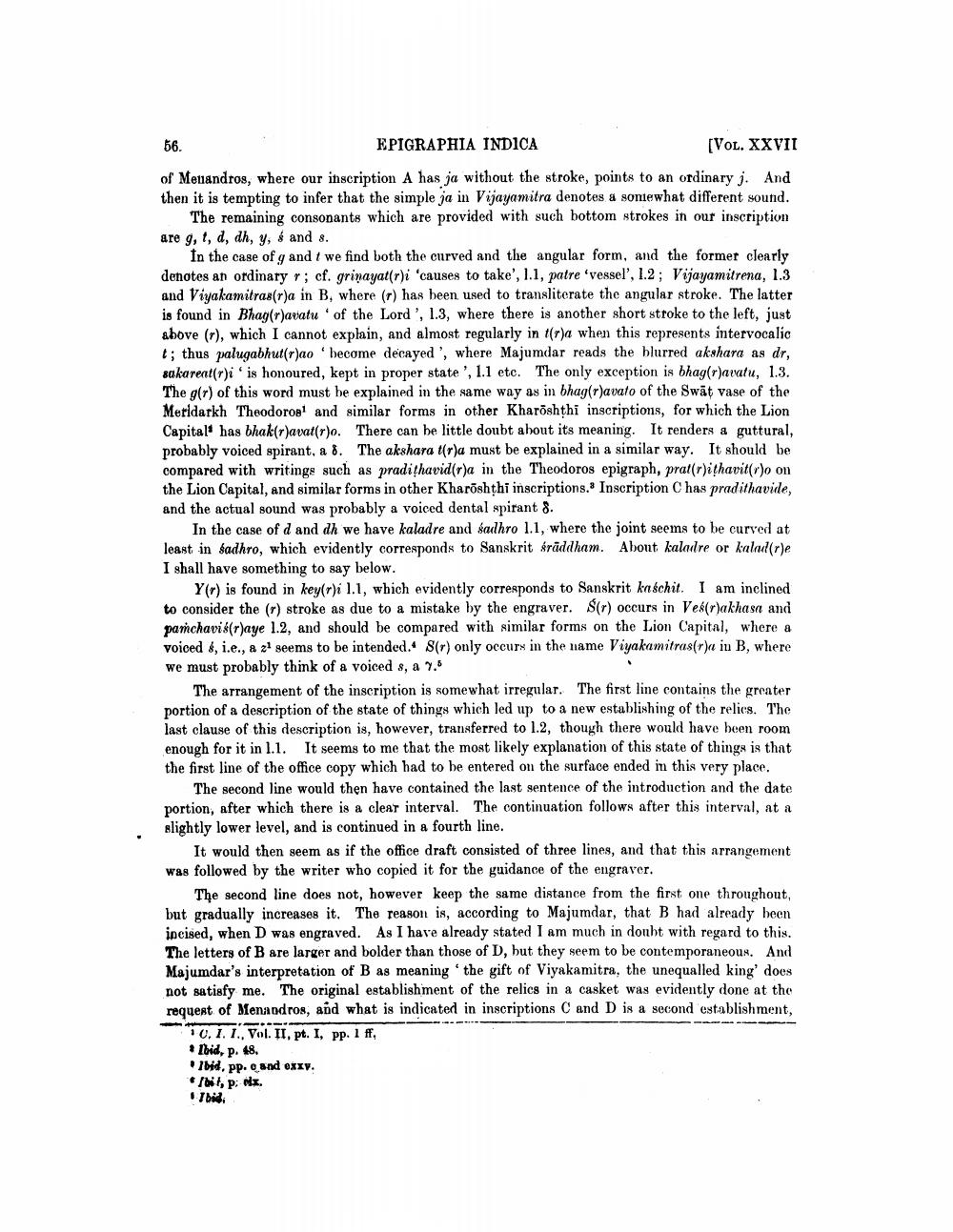________________
56. EPIGRAPHIA INDICA
(VOL. XXVII of Menandros, where our inscription A has ja without the stroke, points to an ordinary j. And then it is tempting to infer that the simple ja in Vijayamitra denotes a sontewhat different sound.
The remaining consonants which are provided with such bottom strokes in our inscription are g, t, d, dh, y, & and 8.
In the case of g and I we find both the curved and the angular form, and the former clearly denotes an ordinary r; cf. grinayat(r)i 'causes to take', 1.1, patre 'vessel', 1.2; Vijayamitrena, 1.3 and Viyakamitras(r)a in B, where (r) has been used to transliterate the angular stroke. The latter is found in Bhaq(r)avatu of the Lord', 1.3, where there is another short stroke to the left, just above (r), which I cannot explain, and almost regularly in (r)a when this represents intervocalic t; thus palugabhut(r)ao 'become decayed', where Majumdar reads the blurred akshara as dr, sakareat(r)i 'is honoured, kept in proper state', 1.1 etc. The only exception is bhag(r)avatu, 1.3. The g() of this word must be explained in the same way as in bhag(r)avalo of the Swāt vase of the Meridarkh Theodorol and similar forms in other Kharðshthi inscriptions, for which the Lion Capital has bhak(r)avat(r). There can be little doubt about its meaning. It renders a guttural, probably voiced spirant, a 8. The akshara t(r)a must be explained in a similar way. It should be compared with writings such as pradiţhavid(r)a in the Theodoros epigraph, pral(r)ithavit(r)o on the Lion Capital, and similar forms in other Kharoshthi inscriptions. Inscription C has pradithavide, and the actual sound was probably a voiced dental spirant 8.
In the case of d and dh we have kaladre and sadhro 1.1, where the joint seems to be curved at least in sadhro, which evidently corresponds to Sanskrit srāddham. About kalaire or kalaut(r)e I shall have something to say below.
Y() is found in key(r)i 1.1, which evidently corresponds to Sanskrit kaschit. I am inclined to consider the (r) stroke as due to a mistake by the engraver. $(r) occurs in Ves(r)akhasa and pamchavis(r)aye 1.2, and should be compared with similar forms on the Lion Capital, where a voiced , i.e., a zt seems to be intended. S(r) only occurs in the name Viyakamitras(r)a in B, where we must probably think of a voiced , a %.
The arrangement of the inscription is somewhat irregular. The first line contains the greater portion of a description of the state of things which led up to a new establishing of the relics. The last clause of this description is, however, transferred to 1.2, though there would have been room enough for it in 1.1. It seems to me that the most likely explanation of this state of things is that the first line of the office copy which had to be entered on the surface ended in this very place.
The second line would then have contained the last sentence of the introduction and the date portion, after which there is a clear interval. The continuation follows after this interval, at a slightly lower level, and is continued in a fourth line.
It would then seem as if the office draft consisted of three lines, and that this arrangement was followed by the writer who copied it for the guidance of the engraver.
The second line does not, however keep the same distance from the first one throughout, but gradually increases it. The reason is, according to Majumdar, that B had already been incised, when D was engraved. As I have already stated I am much in doubt with regard to this. The letters of B are larger and bolder than those of D, but they seem to be contemporaneous. And Majumdar's interpretation of B as meaning the gift of Viyakamitra, the unequalled king' does not satisfy me. The original establishment of the relics in a casket was evidently done at the requent of Menandros, and what is indicated in inscriptions C and D is a second establishment,
10.1. 1., Vol. II, pt. I, pp. 1 ff, * Toid, p. 48.
Ibid, pp. and exxy. ht, pol Ibid.




